Analysis of the Relationship Between Groundwater Dynamics and Changes in Water and Salt in Soil Under Subsurface Pipe Salt Drainage Technology
Abstract
1. Introduction
2. Materials and Methods
2.1. Overview of Experimental Area
2.2. Experimental Design and Implementation Process
2.3. Sample Collection and Parameter Determination
3. Results
3.1. Changes in Groundwater Depth and Groundwater Salinity
3.2. Relationship Between Soil Moisture Content and Groundwater
3.3. Relationship Between Soil Salinity and Groundwater Depth
3.4. Relationship Between Soil Salinity and Groundwater Salinity
3.5. Relationship Among Soil Salinity, Groundwater Depth, and Groundwater Salinity
4. Discussion
5. Conclusions
- (1)
- Both the groundwater depth and salinity in the experimental area exhibited seasonal variations. Specifically, the groundwater exhibited lower salinity and depth in summer, while it had higher salinity and depth in other seasons. The maximum groundwater depth recorded was 1.97 m in October, while the minimum was 1.62 m in July. Groundwater salinity was highest at 22.28 g/L in April and lowest at 18.24 g/L in August.
- (2)
- Soil salinity was lowest at 4.58 g/kg in July and highest at over 5.5 g/kg in April in the experimental area. Soil salinity was positively correlated with groundwater salinity (an exponential relationship) and negatively correlated with groundwater depth (a linear relationship). On the basis of these findings, a relationship between soil salinity, groundwater salinity, and groundwater depth in the low-lying saline soil region of Yellow River irrigation area of Ningxia, was established. This model was validated with actual measurements, resulting in a correlation coefficient R2 of 0.7238.
Author Contributions
Funding
Data Availability Statement
Conflicts of Interest
References
- Tarolli, P.; Luo, J.; Park, E.; Barcaccia, G.; Masin, R. Soil salinization in agriculture: Mitigation and adaptation strategies combining nature-based solutions and bioengineering. iScience 2024, 27, 108830. [Google Scholar] [CrossRef] [PubMed]
- Cuevas, J.; Daliakopoulos, I.; Moral, F.; Hueso, J.; Tsanis, I. A review of soil-improving cropping systems for soil salinization. Agronomy 2019, 9, 295. [Google Scholar] [CrossRef]
- Yang, J.; Yao, R.; Wang, X.; Xie, W.; Zhang, X.; Zhu, W.; Zhang, L.; Sun, R. Research on Salt-affected Soils in China: History, Status Quo and Prospect. Acta Pedol. Sin. 2022, 59, 10–27. (In Chinese) [Google Scholar]
- James, O. History of the roles of gypsum in soil reclamation and establishment of SAR/EC water quality guidelines. In Proceedings of the First IUSS Conference on Sodic Soil Reclamation, Changchun, China, 30 July–2 August 2021. [Google Scholar]
- Liu, T.; Wang, B.; Xiao, H.; Wang, R.; Yang, B.; Cao, Q.; Cao, Y. Differentially improved soil microenvironment and seedling growth of Amorpha fruticosa by plastic, sand and straw mulching in a saline wasteland in northwest China. Ecol. Eng. 2018, 122, 126–134. [Google Scholar] [CrossRef]
- Wang, X.; Shen, J.; Fan, L.; Zhang, Y. Research on Salt Drainage Efficiency and Anti-Siltation Effect of Subsurface Drainage Pipes with Different Filter Materials. Water 2024, 16, 1432. [Google Scholar] [CrossRef]
- Zhang, X.; Shu, C.; Wu, Y.; Ye, P.; Du, D. Advances of coupled water-heat-salt theory and test techniques for soils in cold and arid regions: A review. Geoderma 2023, 432, 116378. [Google Scholar] [CrossRef]
- Hassani, A.; Azapagic, A.; Shokri, N. Global predictions of primary soil salinization under changing climate in the 21st century. Nat. Commun. 2021, 12, 6663. [Google Scholar] [CrossRef]
- Fan, L.; Shen, J.; Wang, X.; Zhang, Y. Effects of Ditch Water and Yellow River Irrigation on Saline-Alkali Characteristics of Soil and Paddy. Water 2024, 16, 2598. [Google Scholar] [CrossRef]
- Li, C.; Gao, X.; Li, S.; Bundschuh, J. A review of the distribution, sources, genesis, and environmental concerns of salinity in groundwater. Environ. Sci. Pollut. Res. 2020, 27, 41157–41174. [Google Scholar] [CrossRef]
- Chen, M.; Wang, G.; Jing, Y.; Zhou, J.; Song, J.; Chang, F.; Yu, R.; Wang, J.; Wang, W.; Sun, X.; et al. Straw interlayer improves sunflower root growth: Evidence from moisture and salt migration and the microbial community in saline-alkali soil. J. Integr. Agric. 2024, 11, 3870–3881. [Google Scholar] [CrossRef]
- Chang, F.; Zhang, H.; Song, J.; Yu, R.; Zhang, X.; Li, H.; Wang, J.; Kan, Z.; Li, Y. Once-middle amount of straw interlayer enhances saline soil quality and sunflower yield in semi-arid regions of China: Evidence from a four-year experiment. J. Environ. Manag. 2023, 344, 118530. [Google Scholar] [CrossRef] [PubMed]
- Lu, P.; Bainard, L.; Liu, J. Bio-fertilizer and rotten straw amendments alter the rhizosphere bacterial community and increase oat productivity in a saline–alkaline environment. Sci. Rep. 2020, 10, 19896. [Google Scholar] [CrossRef] [PubMed]
- Ritzema, H.; Abdel-Dayem, S.; El-Atfy, H.; Nasralla, M.; Shaheen, H. Challenges in modernizing the subsurface drainage systems in Egypt. Agric. Water Manag. 2023, 288, 108484. [Google Scholar] [CrossRef]
- Soe, Y.; Shinogi, Y.; Taniguchi, T. Changes in Certain Paddy Soil Properties under Perforated Sheet Pipe as Subsurface Shallow Drainage. Jpn. Agric. Res. Q. JARQ 2022, 56, 59–66. [Google Scholar] [CrossRef]
- Askri, B.; Khodmi, S.; Bouhlila, R. Impact of subsurface drainage system on waterlogged and saline soils in a Saharan palm grove. Catena 2022, 212, 106070. [Google Scholar] [CrossRef]
- Ghane, E.; Dialamel, B.; Abdalaal, Y.; Ghane, M. Knitted-sock geotextile envelopes increase drain inflow in subsurface drainage systems. Agric. Water Manag. 2022, 274, 107939. [Google Scholar] [CrossRef]
- Yang, J.; Sun, Z.; Wang, X. Analysis of Annual Spatial and Temporal Variation Characteristics of Groundwater Depth, Salinity and Salt ions of Crack Alkaline Land. Water Sav. Irrig. 2016, 3, 45–48. (In Chinese) [Google Scholar]
- Liu, Y.; Ao, C.; Zeng, W.; Srivastava, A.; Gaiser, T.; Wu, J.; Huang, J. Simulating water and salt transport in subsurface pipe drainage systems with HYDRUS-2D. J. Hydrol. 2021, 592, 125823. [Google Scholar] [CrossRef]
- Wang, X.; Zhang, Y.; Fan, L.; Shen, J. Salt Drainage Efficiency and Anti-Clogging Effects of Subsurface Pipes Wrapped with Geotextiles. Water 2024, 16, 1392. [Google Scholar] [CrossRef]
- Negacz, K.; Malek, Z.; Vos, A.; Vellinga, P. Saline soils worldwide: Identifying the most promising areas for saline agriculture. J. Arid. Environ. 2022, 203, 104775. [Google Scholar] [CrossRef]
- Abedi-Koupai, J.; Ansari, S.; Mostafazadeh-Fard, B.; Shayannejad, M.; Mosaddeghi, M. Experimental study and numerical simulation of soil water and salt transport under dry drainage conditions. Environ. Earth Sci. 2020, 79, 89. [Google Scholar] [CrossRef]
- Wang, Z.; Chen, R.; Li, W.; Zhang, J.; Zhang, J.; Song, L.; Wang, J.; Li, H.; Mou, H.; Li, Z.; et al. Mulched drip irrigation: A promising practice for sustainable agriculture in China’s arid region. Npj Sustain. Agric. 2024, 2, 17. [Google Scholar]
- Haj-Amor, Z.; Hashemi, H.; Bouri, S. Soil salinization and critical shallow groundwater depth under saline irrigation condition in a Saharan irrigated land. Arab. J. Geosci. 2017, 10, 301. [Google Scholar]
- Liu, P.; Zhang, G.; Cui, S.; Nie, Z.; Cui, H.; Wang, Q. Effects of Groundwater Level Control on Soil Salinity Change in Farmland around Wetlands in Arid Areas: A Case Study of the Lower Reaches of the Shiyang River Basin, China. Water 2023, 15, 1308. [Google Scholar] [CrossRef]
- Cui, H.; Bai, J.; Du, S.; Wang, J.; Keculah, G.; Wang, W.; Zhang, G.; Jia, J. Interactive effects of groundwater level and salinity on soil respiration in coastal wetlands of a Chinese delta. Environ. Pollut. 2021, 286, 117400. [Google Scholar]
- Zhou, Z.; Zhang, G.; Wang, J.; Yan, M. Spatial pattern of soil salinity and soil salinization in area around Bohai Sea. Trans. Chin. Soc. Agric. Eng. 2010, 26, 15–20+385. (In Chinese) [Google Scholar]
- Zhang, Y.; Hou, K.; Qian, H.; Gao, Y.; Fang, Y.; Xiao, S.; Tang, S.; Zhang, Q.; Qu, W.; Ren, W. Characterization of soil salinization and its driving factors in a typical irrigation area of Northwest China. Sci. Total Environ. 2022, 837, 155808. [Google Scholar]
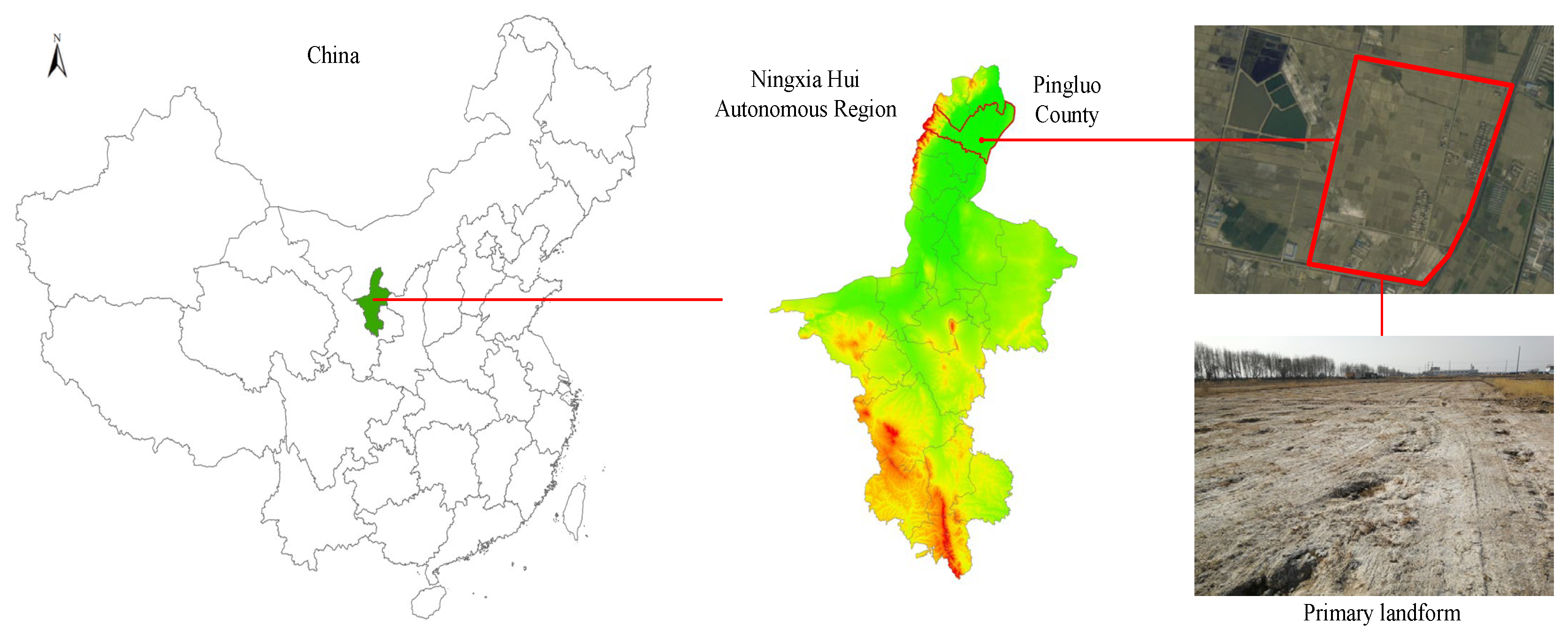


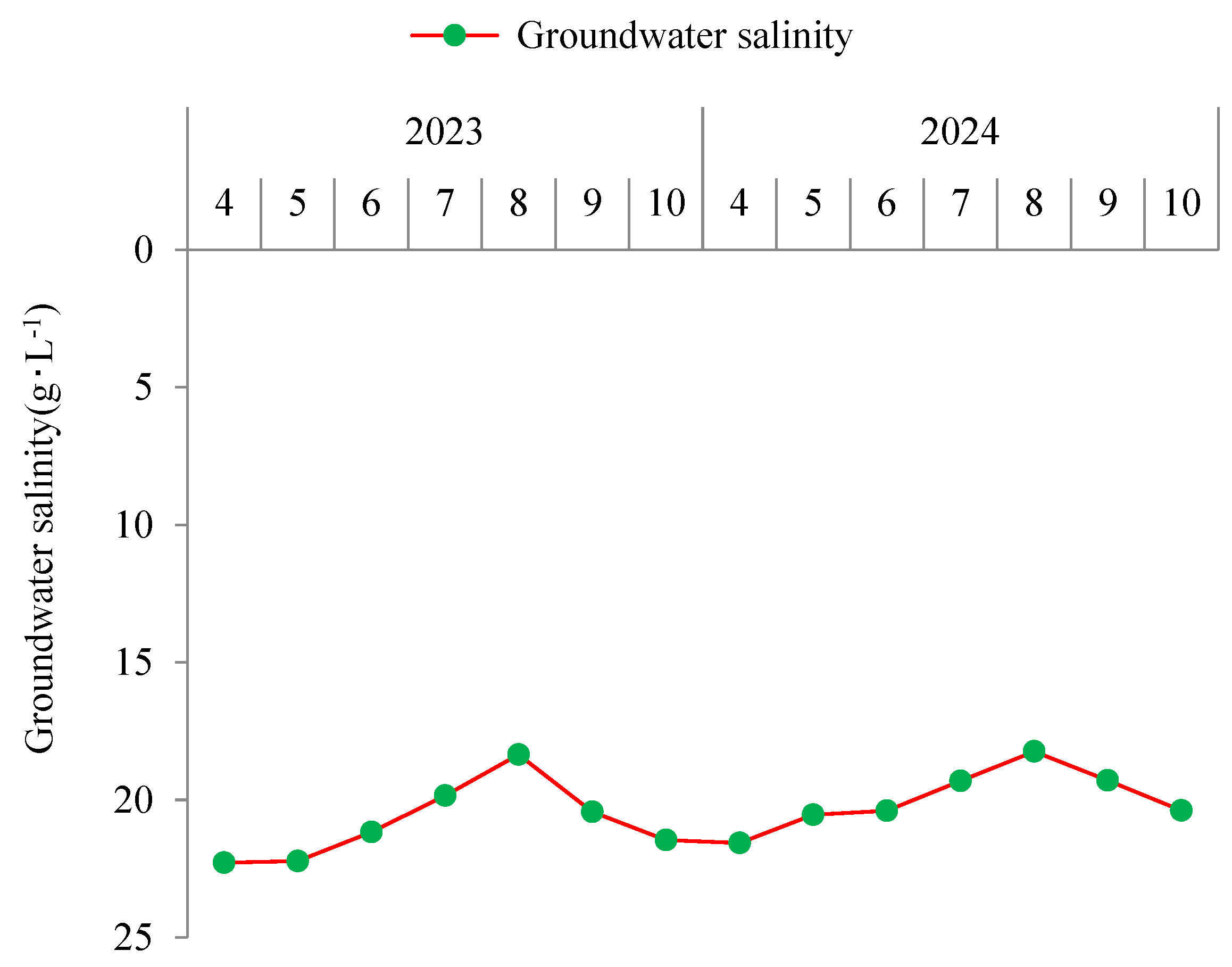


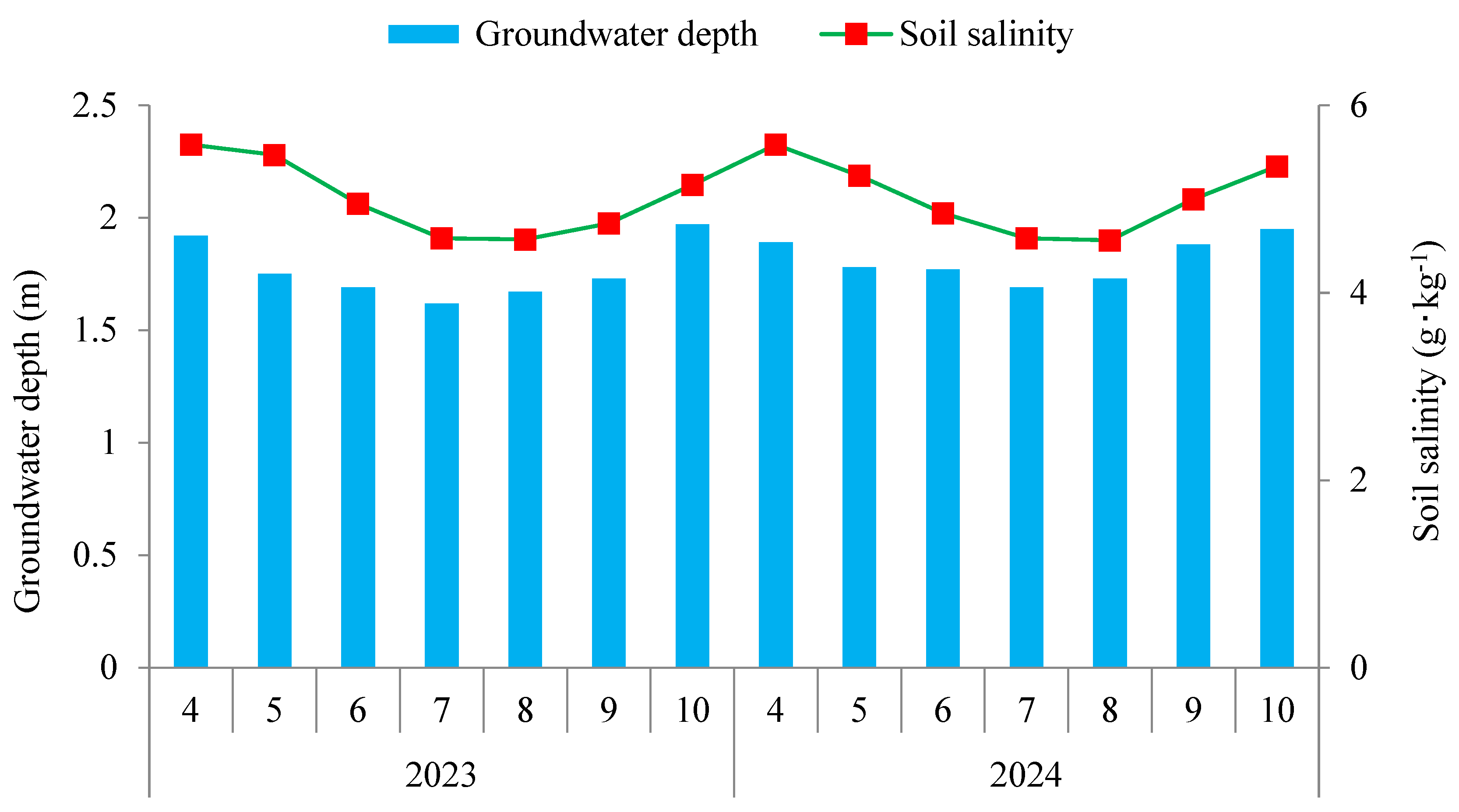

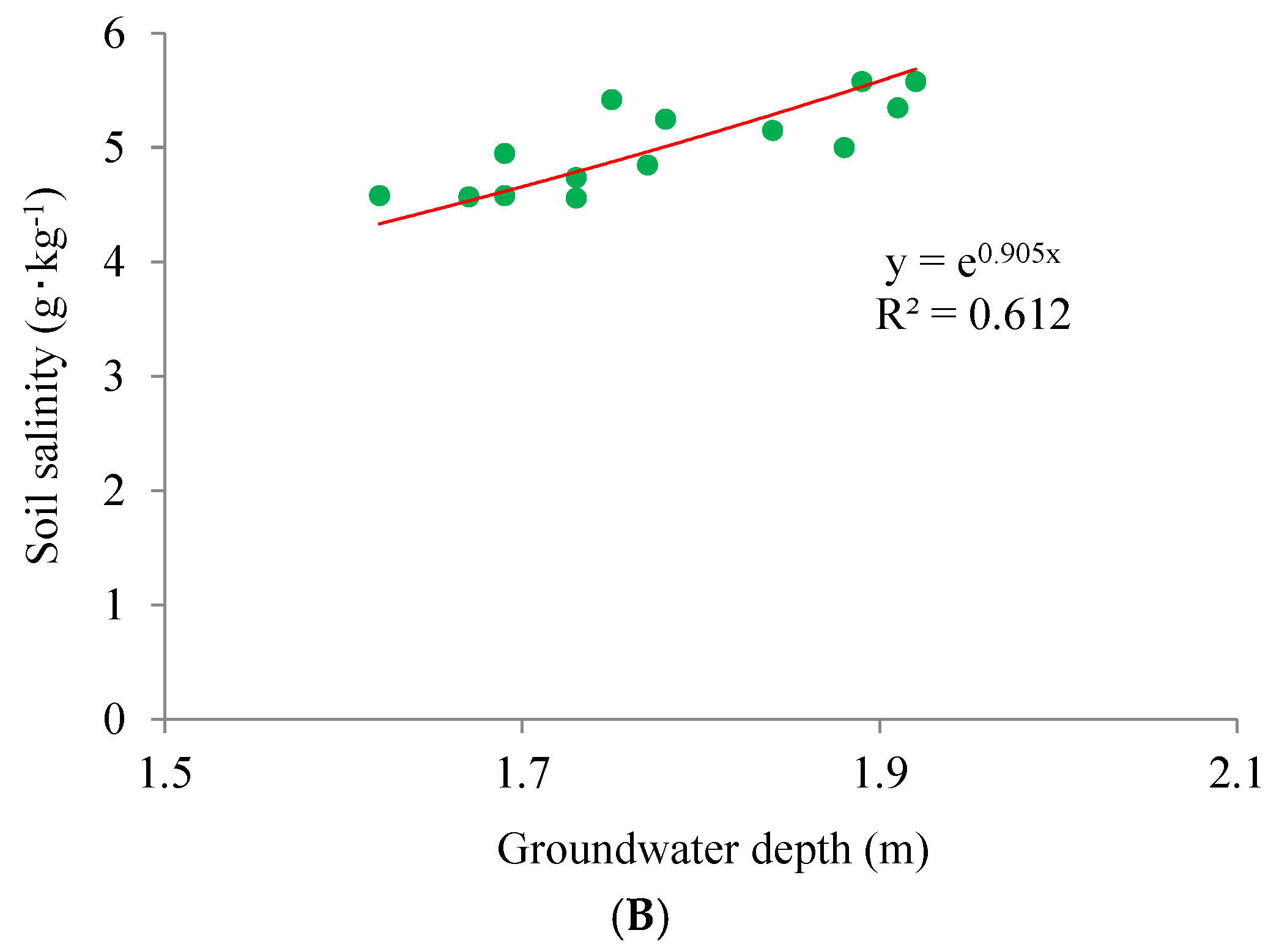
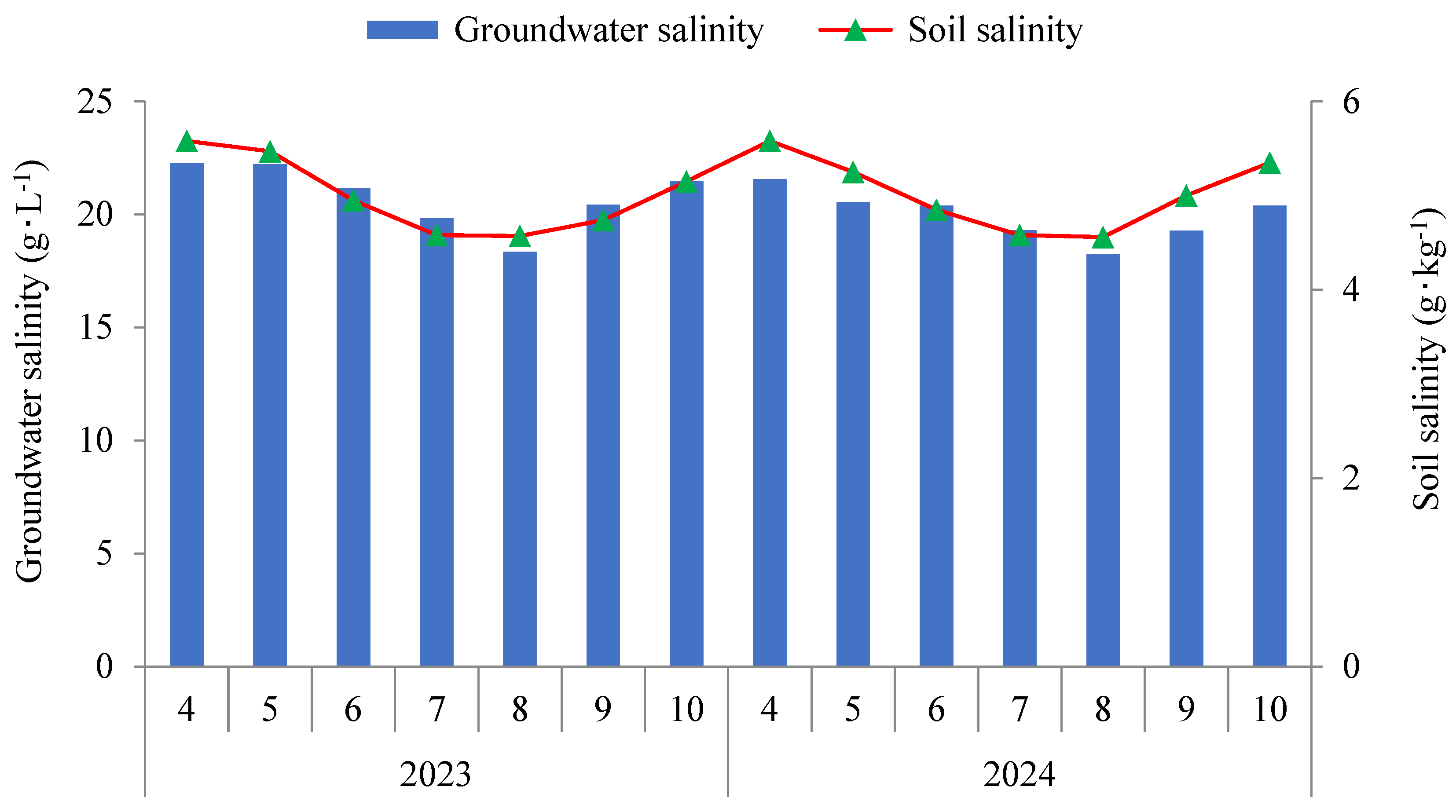


| Soil Depth (cm) | Soil Texture | Field Capacity (%) | Bulk Density (g·cm−3) | Porosity (%) | Salinity (g·kg−1) | pH Value |
|---|---|---|---|---|---|---|
| 0–20 | sandy loam | 18.72 | 1.36 | 48.68 | 10.11 | 8.55 |
| 20–40 | sandy loam | 19.26 | 1.51 | 43.02 | 7.79 | 9.24 |
| 40–60 | sandy loam | 19.87 | 1.62 | 38.87 | 6.21 | 10.10 |
| 60–80 | sandy loam | 20.25 | 1.68 | 36.60 | 5.88 | 9.37 |
| 80–100 | sandy loam | 20.34 | 1.59 | 40.00 | 6.10 | 9.29 |
Disclaimer/Publisher’s Note: The statements, opinions and data contained in all publications are solely those of the individual author(s) and contributor(s) and not of MDPI and/or the editor(s). MDPI and/or the editor(s) disclaim responsibility for any injury to people or property resulting from any ideas, methods, instructions or products referred to in the content. |
© 2024 by the authors. Licensee MDPI, Basel, Switzerland. This article is an open access article distributed under the terms and conditions of the Creative Commons Attribution (CC BY) license (https://creativecommons.org/licenses/by/4.0/).
Share and Cite
Wang, X.; Shen, J.; Fan, L.; Cai, J. Analysis of the Relationship Between Groundwater Dynamics and Changes in Water and Salt in Soil Under Subsurface Pipe Salt Drainage Technology. Water 2024, 16, 3597. https://doi.org/10.3390/w16243597
Wang X, Shen J, Fan L, Cai J. Analysis of the Relationship Between Groundwater Dynamics and Changes in Water and Salt in Soil Under Subsurface Pipe Salt Drainage Technology. Water. 2024; 16(24):3597. https://doi.org/10.3390/w16243597
Chicago/Turabian StyleWang, Xu, Jingli Shen, Liqin Fan, and Jinjun Cai. 2024. "Analysis of the Relationship Between Groundwater Dynamics and Changes in Water and Salt in Soil Under Subsurface Pipe Salt Drainage Technology" Water 16, no. 24: 3597. https://doi.org/10.3390/w16243597
APA StyleWang, X., Shen, J., Fan, L., & Cai, J. (2024). Analysis of the Relationship Between Groundwater Dynamics and Changes in Water and Salt in Soil Under Subsurface Pipe Salt Drainage Technology. Water, 16(24), 3597. https://doi.org/10.3390/w16243597







